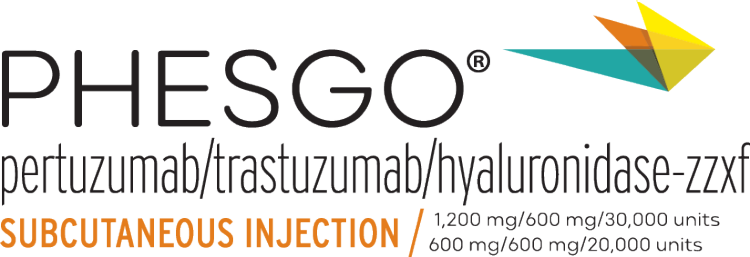PHESGO combines PERJETA® (pertuzumab) and trastuzumab into a single subcutaneous injection that’s administered in ~5 minutes*1
Faster administration with PHESGO vs IV PERJETA + IV trastuzumab*1,2

- Patients should be observed for a minimum of 30 minutes after initial dose of PHESGO and 15 minutes after each maintenance dose of PHESGO for signs of hypersensitivity symptoms or administration-related reactions. Medications to treat such reactions, as well as emergency equipment, should be available for immediate use
*Refers to actual injection time of PHESGO vs infusion time of IV PERJETA + trastuzumab and does not account for all aspects of treatment. Does not include observation time. Actual clinic time may vary. PERJETA and trastuzumab can be given in any order.1,2 Please see the PERJETA full Prescribing Information for additional dosing information for PERJETA + trastuzumab.
PHESGO gives you an opportunity to save time for your patients and practice1,2
Observed Times of PHESGO vs IV PERJETA + IV trastuzumab in a Time & Motion Study3
Time & Motion Study Design
- The Time & Motion study is a prospective, pre-specified substudy of ADEPT. ADEPT is a single-arm Phase 2 study of patients with HER2+ early breast cancer. The Time & Motion study enrolled 22 patients after their initial loading dose of PHESGO
- Each patient in the Time & Motion study received 4 maintenance doses: 2 cycles of IV PERJETA + IV trastuzumab followed by 2 cycles of PHESGO (88 total cycles evaluated)
- Study objective: Estimate the relative difference in time and logistical burden between IV PERJETA + IV trastuzumab and PHESGO
- Primary endpoint: Patient chair time
- Secondary exploratory endpoints: Patient time in clinic, drug administration time, pharmacy drug preparation time
Time & Motion Limitations and Considerations
- Performed at a single US institution (Dana Farber Cancer Institute). Results may not be generalizable to other centers
- Protocol allowed for shorter observation time after IV PERJETA administration than specified in the PERJETA USPI
- Evaluated maintenance doses only and did not review differences in loading dose times
PHESGO time savings for HCPs, patients, and pharmacists vs IV PERJETA + IV trastuzumab3

SD=standard deviation.
†Patients were evaluated from the start of first drug administration to the end of the final post-drug observation period.
‡Patients were evaluated from the infusion room check-in time to the end of the final post-drug observation period. Administration time was also studied and is a component of the chair time and total patient time in clinic endpoints.
§Total pharmacy prep time was evaluated from order receipt by pharmacy to drug leaving the pharmacy.

PHESGO is FDA approved for all of the same HER2+ breast cancer indications as PERJETA.1,2

Most major insurance plans provide coverage for PHESGO*4
*Data current as of June 2025. Insurer policies may vary and are subject to change.
-
-
PHESGO Prescribing Information. Genentech, Inc. 2024.
PHESGO Prescribing Information. Genentech, Inc. 2024.
-
PERJETA Prescribing Information. Genentech, Inc. 2025.
PERJETA Prescribing Information. Genentech, Inc. 2025.
-
Waks AG, Chen EL, Graham N, et al. Subcutaneous vs intravenous trastuzumab/pertuzumab: a time and motion substudy of a phase II trial of adjuvant trastuzumab/pertuzumab for stage I HER2+ breast cancer (ADEPT trial). J Oncol Pract. 2025;21(3):351-357 and Supplementary Material. doi:10.1200/OP.24.00021
Waks AG, Chen EL, Graham N, et al. Subcutaneous vs intravenous trastuzumab/pertuzumab: a time and motion substudy of a phase II trial of adjuvant trastuzumab/pertuzumab for stage I HER2+ breast cancer (ADEPT trial). J Oncol Pract. 2025;21(3):351-357 and Supplementary Material. doi:10.1200/OP.24.00021
-
Data on file. Genentech, Inc. MMIT Analysis. HLI Lives Database.
Data on file. Genentech, Inc. MMIT Analysis. HLI Lives Database.
-
-
